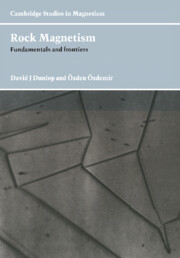Book contents
- Frontmatter
- Contents
- Preface
- Chapter 1 Magnetism in nature
- Chapter 2 Fundamentals of magnetism
- Chapter 3 Terrestrial magnetic minerals
- Chapter 4 Magnetostatic fields and energies
- Chapter 5 Elementary domain structures and hysteresis
- Chapter 6 Domain observations
- Chapter 7 Micromagnetic calculations
- Chapter 8 Single-domain thermoremanent magnetization
- Chapter 9 Multidomain thermoremanent magnetization
- Chapter 10 Viscous and thermoviscous magnetization
- Chapter 11 Isothermal magnetization and demagnetization
- Chapter 12 Pseudo-single-domain remanence
- Chapter 13 Crystallization remanent magnetization
- Chapter 14 Magnetism of igneous rocks and baked materials
- Chapter 15 Magnetism of sediments and sedimentary rocks
- Chapter 16 Magnetism of metamorphic rocks
- Chapter 17 Magnetism of extraterrestrial rocks
- References
- Index
Chapter 12 - Pseudo-single-domain remanence
Published online by Cambridge University Press: 06 July 2010
- Frontmatter
- Contents
- Preface
- Chapter 1 Magnetism in nature
- Chapter 2 Fundamentals of magnetism
- Chapter 3 Terrestrial magnetic minerals
- Chapter 4 Magnetostatic fields and energies
- Chapter 5 Elementary domain structures and hysteresis
- Chapter 6 Domain observations
- Chapter 7 Micromagnetic calculations
- Chapter 8 Single-domain thermoremanent magnetization
- Chapter 9 Multidomain thermoremanent magnetization
- Chapter 10 Viscous and thermoviscous magnetization
- Chapter 11 Isothermal magnetization and demagnetization
- Chapter 12 Pseudo-single-domain remanence
- Chapter 13 Crystallization remanent magnetization
- Chapter 14 Magnetism of igneous rocks and baked materials
- Chapter 15 Magnetism of sediments and sedimentary rocks
- Chapter 16 Magnetism of metamorphic rocks
- Chapter 17 Magnetism of extraterrestrial rocks
- References
- Index
Summary
Introduction
Most magnetite grains in rocks are much larger than the critical SD size d0 of ≈0.1 μm. Yet these rocks possess a TRM that is both harder and more intense than MD theory predicts. In magnetite there is no abrupt change from SD to MD TRM intensity at any grain size (Fig. 8.4). Instead TRM intensity decreases continuously above d0, reaching MD levels around 10–20 μm. In high-titanium titanomagnetites, the corresponding range is ≈0.5–35 μm (Day, 1977, Fig. 9). This pseudo-single-domain (PSD) (Stacey, 1963) size range incorporates most of the magnetite or titanomagnetite carrying stable TRM in igneous rocks. Therefore it is important that we understand the mechanism of PSD remanence.
The size dependence of TRM is not well documented except in titanomagnetites. However, strong-field remanence parameters like Mrs and Hc vary gradually over broad size ranges in a great many minerals, rather than changing sharply around d0 (Fig. 12.1). In §11.9.4, we saw that most measured values of Mrs/Ms and Hcr/Hc are intermediate between SD and ideal MD values. Pseudo-single-domain behaviour seems to be an intrinsic feature of small MD grains rather than a special property of certain minerals.
The mechanism of PSD behaviour is still far from certain (for reviews of experimental data and theories, see Day, 1977; Dunlop, 1977, 1981, 1986b, 1990; Halgedahl and Fuller, 1983; Fuller, 1984; Halgedahl, 1987). Verhoogen (1959) proposed regions of deflected spins surrounding dislocations, while Stacey (1963) preferred ‘Barkhausen discreteness’ of domain-wall positions.
- Type
- Chapter
- Information
- Rock MagnetismFundamentals and Frontiers, pp. 328 - 366Publisher: Cambridge University PressPrint publication year: 1997
- 1
- Cited by



